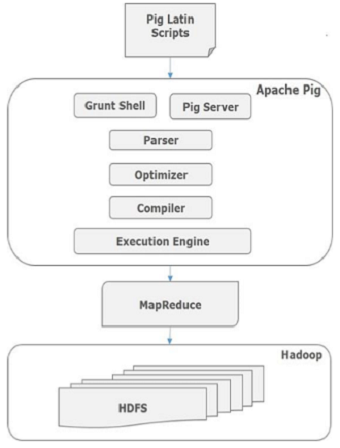Architecture:
The language used to analyze data in Hadoop using Pig is known as Pig Latin. It is a highlevel data processing language which provides a rich set of data types and operators to perform various operations on the data.
To perform a particular task Programmers using Pig, programmers need to write a Pig script using the Pig Latin language, and execute them using any of the execution mechanisms (Grunt Shell, UDFs, Embedded). After execution, these scripts will go through a series of transformations applied by the Pig Framework, to produce the desired output.
Internally, Apache Pig converts these scripts into a series of MapReduce jobs, and thus, it makes the programmer’s job easy. The architecture of Apache Pig is shown below.

Apache Pig Components
As shown in the figure, there are various components in the Apache Pig framework. Let us take a look at the major components.
Parser
Initially the Pig Scripts are handled by the Parser. It checks the syntax of the script, does type checking, and other miscellaneous checks. The output of the parser will be a DAG (directed acyclic graph), which represents the Pig Latin statements and logical operators.
In the DAG, the logical operators of the script are represented as the nodes and the data flows are represented as edges.
Optimizer
The logical plan (DAG) is passed to the logical optimizer, which carries out the logical optimizations such as projection and pushdown.
Compiler
The compiler compiles the optimized logical plan into a series of MapReduce jobs.
Execution engine
Finally the MapReduce jobs are submitted to Hadoop in a sorted order. Finally, these MapReduce jobs are executed on Hadoop producing the desired results.